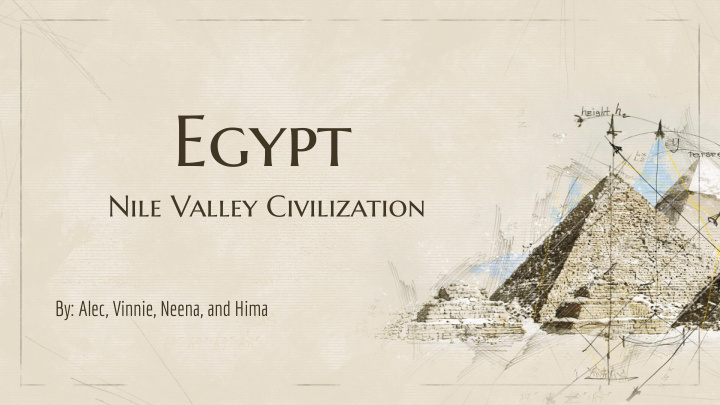



Egypt Nile Valley Civilization By: Alec, Vinnie, Neena, and Hima
Name Origins
Egypt Aegyptos (Greek) “Hwt-Ka-Ptah”
Geography
Modern day Egypt Protected by desert to East and West and the Mediterranean Sea to the North
Nile River
Architecture & Art
Stepping Pyramid at Saqqara: Tomb of Pharaoh Zoser Materials: ❖ Mudbrick ❖ Reed ❖ Timber ❖ Limestone
The Pyramids of Giza: Tomb Site of Cheops, Chephren, and Mycerinus Accessories: Royal tomb complex ❖ A mortuary temple ❖ Solar boat pits ❖ Sphinx ❖
Make your own Sculpture
Art: Sculptures
Political Structure
Judicial System ❖ Laws were derived from religion ❖ Djadjat → Kenbet → Seru ➢ Districts: Nomes ➢ Governor: Nomarch ❖ Guilty until proven innocent ❖ Punishments for serious crimes were cruel ➢ Disfjgurement or Death
Government ❖ King → Vizier → Local Offjcials ❖ Divine Absolute Monarchy ➢ Kings considered human Gods ❖ Centralized Government ➢ Capital was Memphis ❖ Kingship passed from father to son ❖ Priests gained wealth and power ❖ Kings and Offjcials became complacent
Economy ❖ Agrarian and Barter Economy ❖ No physical currency, debens defjne value ➢ To quantify fair trade (1 = 90g of gold) ❖ Produce ‘taxes’ were used in trade ➢ Shemsu Hor ❖ Trade brought wealth and resources for building projects (pyramids) ❖ Yam was a major trade center in Nubia
Hierarchies
Class Structure ❖ King (Pharaohs were New Kingdom) ❖ Vizier ❖ Offjcials/Nobles/Priests ❖ Soldiers/Scribes ❖ Craftsmen/Merchants/Business Owners ❖ Farmers/Unskilled Workers ❖ Slaves
Gender Dynamics ❖ Women could use the legal system ➢ Divorce, infjdelity, business arguments ❖ Most occupations open to women, could become powerful through religious cults ❖ Both male and female deities ❖ Women could own property independently ❖ Marriages were not arranged or binding ❖ Queens could take over duties of Kings
Communication
Try it yourself! Write your name out in Hieroglyphics!
Writing ➢ Hieroglyphics ➢ Sounds, words, ideas ➢ History, business, scientifjc and literary purpose ➢ Rosetta stone → ➢ Thoth ➢ Simplifjed to an alphabet
Check Your Work! Jackie Julia Anvi Anika Will Hima Arjun Isabella Toyesh Jefg Vinnie Neena Shri Akhi Alec Matt
Language ❖ Afro-Asiatic language ❖ Consisted of 3 consonants ❖ Words had gender (masculine and feminine)
Religion
The Gods Concept of Heka (Magic) ★ Relationship = Money ○ Gods for various purposes ★ Osiris, Isis, Set, Nephthys, and Horus ○ Theban Triad: Amun, Mut, and Knons (also known as ★ Khonsu). Amun, Mut, and Khons of Upper Egypt (where Thebes ○ was located) took on the attributes of Ptah, Sekhmet, and Khonsu of Lower Egypt who were much older deities. Amun - supreme creator god, symbolized by the sun ○ Mut - his wife, symbolized by the sun's rays and the ○ all-seeing eye Khons was their son, the god of healing and destroyer of ○ evil spirits.
Family Tree
Harmony & Eternity Relationship with others ❖ The 'gateway sin' - ingratitude ❖ Plants and fmowers ❖ Flowers of the Ished tree ➢ The Five Gifts of Hathor ❖ The after-life ❖
The Soul & The Hall of Truth Parts of the soul ❖ Khat - the physical body ➢ Ka - one’s double-form ➢ Ba - a human-headed bird aspect which could speed ➢ between earth and the heavens Shuyet - the shadow self ➢ Akh - the immortal, transformed self ➢ Sahu - Sechem were aspects of the Akh ➢ Ab - the heart, the source of good and evil ➢ Ren - one’s secret name. ➢ Negative Confession and Thoth (God of Wisdom) ❖ The feather of truth ❖ Monster Ammut vs Field of Reeds ➢
Myth OSIRIS & ISIS
Work Cited “Ancient Egypt Culture.” Natural Resources in Ancient Egypt , http://historylink101.com/n/egypt_1/a-natural_resources.htm. Forman, Werner. “Pyramids at Giza.” Pyramids of Giza | National Geographic , 23 Mar. 2017, https://www.nationalgeographic.com/history/archaeology/giza-pyramids/. Mark, Joshua J. “Ancient Egypt.” Ancient History Encyclopedia , Ancient History Encyclopedia, 28 Sept. 2019, https://www.ancient.eu/egypt/. Mark, Joshua J. “Old Kingdom of Egypt.” Ancient History Encyclopedia , Ancient History Encyclopedia, 27 Sept. 2019, https://www.ancient.eu/Old_Kingdom_of_Egypt/. Mark, Joshua J. “Ancient Egyptian Government.” Ancient History Encyclopedia , Ancient History Encyclopedia, 29 Sept. 2019, https://www.ancient.eu/Egyptian_Government/. Mark, Joshua J. “Ancient Egyptian Law.” Ancient History Encyclopedia , Ancient History Encyclopedia, 29 Sept. 2019, https://www.ancient.eu/Egyptian_Law/. Mark, Joshua J. “Women in Ancient Egypt.” Ancient History Encyclopedia , Ancient History Encyclopedia, 28 Sept. 2019, https://www.ancient.eu/article/623/women-in-ancient-egypt/. “Memories of Egypt.” Egyptian Civilization - Religion , https://www.historymuseum.ca/cmc/exhibitions/civil/egypt/egcr01e.html. Nile Valley Civilization , http://www.taneter.org/nile.html “Egyptian Spoken Hieros Afro-Asiatic Language Historical Monuments.” Facts About Ancient Egyptians , http://www.ancientegyptianfacts.com/ancient-egyptian-language.html. “Ancient Egyptian Art and Culture.” Ancient Egyptian Art and Culture - Albany Institute of History and Art , https://www.albanyinstitute.org/ancient-egyptian-art-and-culture.html.
Recommend
More recommend